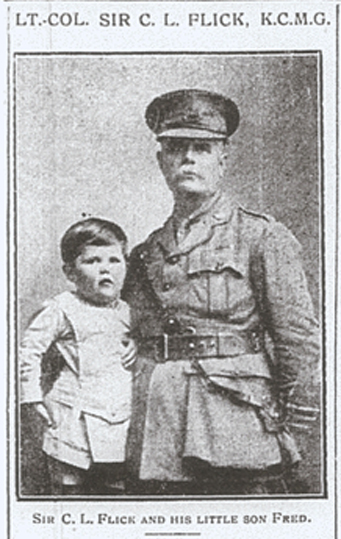Charles Flick was born in Halesworth, Suffolk, on 20th December 1869. He was educated at Fauconberg Grammar School in Beccles and then Felstead in Essex. Charles’ first job was as a clerk for a wholesale company in London. While there, he had his first taste of the military when he joined the Honourable Artillery Company – the oldest Regiment in the British Army. When the Boer War broke out in South Africa in 1899, Charles left his job to join the South African Light Horse in Cape Colony with whom he saw action at Colenso, Spion Kop, Tugela Heights, the relief of Ladysmith, Laing’s Nek and Belfast. Charles was also mentioned in General Buller’s despatches for “successfully carrying out dangerous duties.”
On his return to England, at the end of the Boer War, Charles volunteered to go back to South Africa for service in Somaliland and was sent to Aldershot for training. After three months, Charles and the other officers on the training programme were told their services were no longer required. Feeling disillusioned, he decided to emigrate to Canada.
On 30th November 1904, Charles married Marie Millwood in Mayne Island, British Columbia. By 1911 they had two daughters, Charlotte and Violet. Charles’ occupation at that time was shown as a merchant. He was also a serving member of the Canadian Militia and, by 1914, he’d risen through the ranks to become the Commanding Officer of the 31st British Columbia Horse. At the start of the First World War, Charles left Canada for Britain. He joined the 12th Battalion Royal Fusiliers followed by the 7th Essex Regiment. Charles and the 7th Essex Regiment were posted to Gallipoli where he was wounded by shrapnel from a shell. After treatment in hospital and two months leave, he was posted to join the 6th Devonshire Regiment in Mesopotamia.
During the war, Charles was mentioned in despatches on three occasions and in the 1916 King’s Birthday Honours he became a Commander of St Michael and St George (CMG) for “Services rendered in connection with Military Operations in the Field.”
When the war was over, Charles remained with the British Army and served in India, taking part in the Third Afghan War between 1919 and 1920. He was twice more mentioned in despatches.
Charles returned to Canada with his family in May 1920. He served with the militia until 1929 when he retired having achieved the rank of Brigadier-General. He was the author of several books including The History of the British Columbian Horse and Record of the 6th Devons in the Great War. He also wrote The Ballad of Vimy Ridge, a short book of poetry about the Canadian Army during the war.
During the Second World War, Charles was appointed Registrar of Enemy Aliens and Reporting Officer for Japanese residents in the Gulf Islands in British Columbia. He was very supportive of the Japanese- Canadians in British Columbia and protested over their forced evacuation from the islands.
Charles died in Victoria, British Columbia, on 8th February 1948. During his time in the Armed Forces, he received the King’s South Africa Medal with Clasps, the 1914-15 Star, British War and Victory Medals and the Indian General Service Medal with Afghan Clasp.

